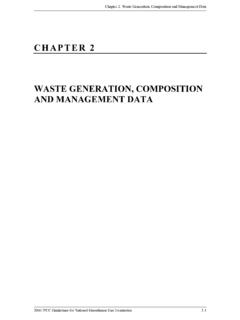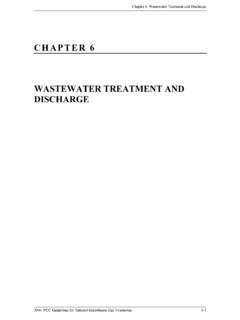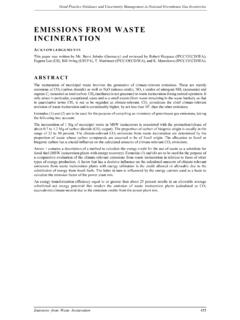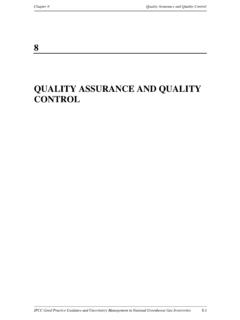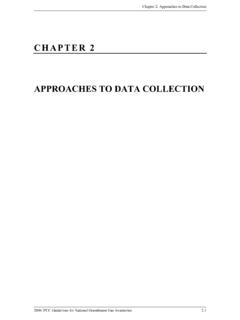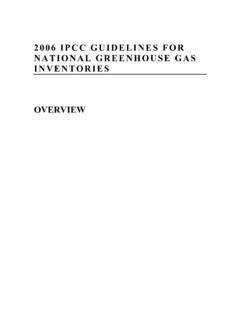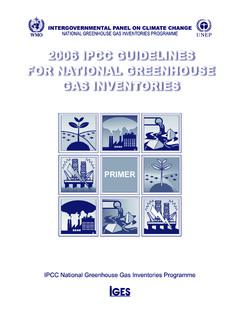Transcription of CHAPTER 4 BIOLOGICAL TREATMENT OF SOLID WASTE
1 CHAPTER 4: BIOLOGICAL TREATMENT of SOLID WASTE 2006 IPCC Guidelines for National Greenhouse Gas Inventories 4. 1 CHAPTER 4 BIOLOGICAL TREATMENT OF SOLID WASTE Volume 5: WASTE 4. 2 2006 IPCC Guidelines for National Greenhouse Gas Inventories Authors Riitta Pipatti (Finland) Joao Wagner Silva Alves (Brazil), Qingxian Gao (China), Carlos L pez Cabrera (Cuba), Katarina Mareckova (Slovakia), Hans Oonk (Netherlands), Elizabeth Scheehle (USA), Chhemendra Sharma (India), Alison Smith (UK), Per Svardal (Norway), and Masato Yamada (Japan) CHAPTER 4: BIOLOGICAL TREATMENT of SOLID WASTE 2006 IPCC Guidelines for National Greenhouse Gas Inventories 4. 3 Contents 4 BIOLOGICAL TREATMENT of SOLID WASTE Methodological issues.
2 Choice of method .. Choice of activity data .. Choice of emission factors .. Completeness .. Developing a consistent time series .. Uncertainty assessment .. QA/QC .. Reporting and Documentation .. References .. Equations Equation CH4 emissions from BIOLOGICAL TREATMENT .. Equation N2O emissions from BIOLOGICAL TREATMENT .. Tables Table Default emission factors for CH4 and N2O emissions from BIOLOGICAL TREATMENT of WASTE .. Volume 5: WASTE 4. 4 2006 IPCC Guidelines for National Greenhouse Gas Inventories 4 BIOLOGICAL TREATMENT OF SOLID WASTE METHODOLOGICAL ISSUES Composting and anaerobic digestion of organic WASTE , such as food WASTE , garden (yard) and park WASTE and sludge, is common both in developed and developing countries.
3 Advantages of the BIOLOGICAL TREATMENT include: reduced volume in the WASTE material, stabilisation of the WASTE , destruction of pathogens in the WASTE material, and production of biogas for energy use. The end products of the BIOLOGICAL TREATMENT can, depending on its quality, be recycled as fertiliser and soil amendment, or be disposed in SWDS. Anaerobic TREATMENT is usually linked with methane (CH4) recovery and combustion for energy, and thus the greenhouse gas emissions from the process should be reported in the Energy Sector. Anaerobic sludge TREATMENT at wastewater TREATMENT facilities is addressed in CHAPTER 6, Wastewater TREATMENT and Discharge, and emissions should be reported under the categories of Wastewater.
4 However, when sludge from wastewater TREATMENT is transferred to an anaerobic facility which is co-digesting sludge with SOLID municipal or other WASTE , any related CH4 and nitrous oxide (N2O) emissions should be reported under this category, BIOLOGICAL TREATMENT of SOLID WASTE . Where these gases are used for energy, then associated emissions should be reported in the Energy Sector. Composting is an aerobic process and a large fraction of the degradable organic carbon (DOC) in the WASTE material is converted into carbon dioxide (CO2). CH4 is formed in anaerobic sections of the compost, but it is oxidised to a large extent in the aerobic sections of the compost.
5 The estimated CH4 released into the atmosphere ranges from less than 1 percent to a few per cent of the initial carbon content in the material (Beck-Friis, 2001; Detzel et al., 2003; Arnold, 2005). Composting can also produce emissions of N2O. The range of the estimated emissions varies from less than percent to 5 percent of the initial nitrogen content of the material (Petersen et al., 1998; Hellebrand 1998; Vesterinen, 1996; Beck-Friis, 2001; Detzel et al., 2003). Poorly working composts are likely to produce more both of CH4 and N2O ( , Vesterinen, 1996). Anaerobic digestion of organic WASTE expedites the natural decomposition of organic material without oxygen by maintaining the temperature, moisture content and pH close to their optimum values.
6 Generated CH4 can be used to produce heat and/or electricity, wherefore reporting of emissions from the process is usually done in the Energy Sector. The CO2 emissions are of biogenic origin, and should be reported only as an information item in the Energy Sector. Emissions of CH4 from such facilities due to unintentional leakages during process disturbances or other unexpected events will generally be between 0 and 10 percent of the amount of CH4 generated. In the absence of further information, use 5 percent as a default value for the CH4 emissions. Where technical standards for biogas plants ensure that unintentional CH4 emissions are flared, CH4 emissions are likely to be close to zero.
7 N2O emissions from the process are assumed to be negligible, however, the data on these emissions are very scarce. Mechanical- BIOLOGICAL (MB) TREATMENT of WASTE is becoming popular in Europe. In MB TREATMENT , the WASTE material undergoes a series of mechanical and BIOLOGICAL operations that aim to reduce the volume of the WASTE as well as stabilise it to reduce emissions from final disposal. The operations vary by application. Typically, the mechanical operations separate the WASTE material into fractions that will under go further TREATMENT (composting, anaerobic digestion, combustion, recycling). These may include separation, shredding and crushing of the material.
8 The BIOLOGICAL operations include composting and anaerobic digestion. The composting can take place in heaps or in composting facilities with optimisation of the conditions of the process as well as filtering of the produced gas. The possibilities to reduce the amount of organic material to be disposed at landfills are large, 40 - 60 percent (Kaartinen, 2004). Due to the reduced amount in material, organic content and BIOLOGICAL activity, the MB-treated WASTE will produce up to 95 percent less CH4 than untreated WASTE when disposed in SWDS. The practical reductions have been smaller and depend on the type and duration of MB treatments in question (see , Binner, 2002). CH4 and N2O emissions during the different phases of the MB TREATMENT depend on the specific operations and the duration of the BIOLOGICAL TREATMENT .
9 Overall, BIOLOGICAL TREATMENT of WASTE affects the amount and composition of WASTE that will be deposited in SWDS. WASTE stream analyses (see example in Box ) are recommended methodologies for estimating the impact of the BIOLOGICAL TREATMENT on emissions from SWDS. The estimation of CH4 and N2O emissions from BIOLOGICAL TREATMENT of SOLID WASTE involves following steps: CHAPTER 4: BIOLOGICAL TREATMENT of SOLID WASTE 2006 IPCC Guidelines for National Greenhouse Gas Inventories 4. 5 Step 1: Collect data on the amount and type of SOLID WASTE which is treated biologically. Data on composting and anaerobic TREATMENT should be collected separately, where possible. Regional default data on composting are provided in Table in CHAPTER 2, and country-specific data for some countries can be found in Annex of this Volume.
10 Anaerobic digestion of SOLID WASTE can be assumed to be zero where no data are available. The default data should be used only when country-specific data are not available (see also Section ). Step 2: Estimate the CH4 and N2O emissions from BIOLOGICAL TREATMENT of SOLID WASTE using Equations and Use default or country-specific emission factors in accordance with the guidance as provided in Sections , and Step 3: Subtract the amount of recovered gas from the amount of CH4 generated to estimate net annual CH4 emissions, when CH4 emissions from anaerobic digestion are recovered. Consistency between CH4 and N2O emissions from composting or anaerobic TREATMENT of sludge and emissions from TREATMENT of sludge reported in the Wastewater TREATMENT and Discharge category should be checked.
